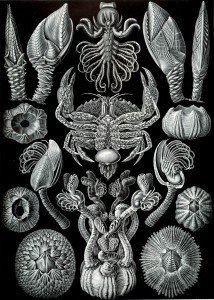Wallace and Intelligent Design: A Response to John M. Lynch
 "Cirripedia" from Haeckel's Kunstformen der Natur (Art Forms of Nature), 1904
"Cirripedia" from Haeckel's Kunstformen der Natur (Art Forms of Nature), 1904“Puttering with barnacles”
Over a month ago John M. Lynch posted (on his aptly titled blog “a simple prop”–need I say more) a rant against my book, Alfred Russel Wallace’s Theory of Intelligent Evolution, making a number of charges that warrant reply. Since his promised part 2 has never materialized, I’ll remain silent no longer lest he delude himself into thinking that no answer implies anything close to a concession. Therefore, I begin with what I have–his ramblings part 1.
With an eagerness reminiscent of Barney Fife’s effort to display his prowess at marksmanship, Lynch begins by getting the bullet out of his pocket and firing an impetuous “gottcha” at William Dembski. Claiming that Dembski’s foreword “doesn’t start off well,” his vapid reading takes issue with the fact that when a shocked Darwin received Wallace’s Ternate letter outlining natural selection in 1858, the Down House dawdler was prompted into action to release his long-labored production Origin and could no longer (in Dembski’s words) “putter with barnacles.” Darwin “hadn’t ‘puttered’ with them in over four years,” Lynch wails. Like Barney’s errant proficiency with firearms and overly enthusiastic commitment to the letter of the law, Lynch’s shot falls wide of the mark as does his misguided application of historical accuracy. Here’s why.
Read More › Yesterday I met with the literary publicist hired by Broadman & Holman to promote The End of Christianity when it is released November 1st (for the Amazon.com listing, go
Yesterday I met with the literary publicist hired by Broadman & Holman to promote The End of Christianity when it is released November 1st (for the Amazon.com listing, go